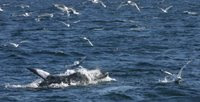
It’s been a lethargic few days, the birders frustrated by lack of birds (see the form for MS5 in the photo above from a few days ago), and when they did appear it was in the wake of the fishing trawlers crossing our bows leaving a stream of stuffed gannets and fulmars sitting on the surface burping (ok, maybe I embellish a little…).

 Even everyone on the ship has had a sleepy look about them, as if walking in a trance. But the weather has been improving day on day, and with the good weather, more sunfish (check out the two photos on the left), and a large school of mackerel tucked in around the back of the ship, clustered around the turbulence profiler.
Even everyone on the ship has had a sleepy look about them, as if walking in a trance. But the weather has been improving day on day, and with the good weather, more sunfish (check out the two photos on the left), and a large school of mackerel tucked in around the back of the ship, clustered around the turbulence profiler.  We watched them glinting in the sun for a few hours before the fishing rod came out, and before long Viv (pictured on the right below with some mackerel), Beth, Inigo, Susan & Romaine had caught 40 mackerel. The chef cooked them up for tea today… yummy :o)
We watched them glinting in the sun for a few hours before the fishing rod came out, and before long Viv (pictured on the right below with some mackerel), Beth, Inigo, Susan & Romaine had caught 40 mackerel. The chef cooked them up for tea today… yummy :o)As for the science, it’s been quite interesting to go and explore our new control site (MS5) – which was indeed much like we expected – no feeding birds and not a huge amount of fish. We’ve also done grab sampling of the sediment at the bottom of the sea to see how it changes from MS5, over the bank to MS4. Nick (our benthic animal expert from the University of Dublin) had a lot of fun sifting through the sand or mud digging out the creatures – there were some cool looking worms, and a lovely shrimp with a green head and bright pink body. Even Morten captured a nephrops (type of shrimp) in his core sample, which proceeded to dig a tunnel out of the sand in the core (see photo on the left).
 You could see the shrimp through the Perspex tube, shovelling sand along the tunnel and out onto the surface – nature in action :o) After taking sediment samples, it was back to the slope part of the bank (MS2) to carry out a 2nd 25 hour turbulence profile station – and with that, and the echosounder we were able to see the classic set-up of the internal waves: the deepening of the thermocline as the current speeds up off the bank, and then as the tidal current relaxes, the thermocline releases with a 30m change in the depth of the thermocline creating internal waves. It wasn’t as dramatic as the last springs (this is a much smaller spring tide than at the beginning of the survey), but it was still nice to watch.
You could see the shrimp through the Perspex tube, shovelling sand along the tunnel and out onto the surface – nature in action :o) After taking sediment samples, it was back to the slope part of the bank (MS2) to carry out a 2nd 25 hour turbulence profile station – and with that, and the echosounder we were able to see the classic set-up of the internal waves: the deepening of the thermocline as the current speeds up off the bank, and then as the tidal current relaxes, the thermocline releases with a 30m change in the depth of the thermocline creating internal waves. It wasn’t as dramatic as the last springs (this is a much smaller spring tide than at the beginning of the survey), but it was still nice to watch.So that’s the catch up blog – and I’ll stop there, because today’s adventures are another blog entirely… and will follow in only an hour or two…


No comments:
Post a Comment